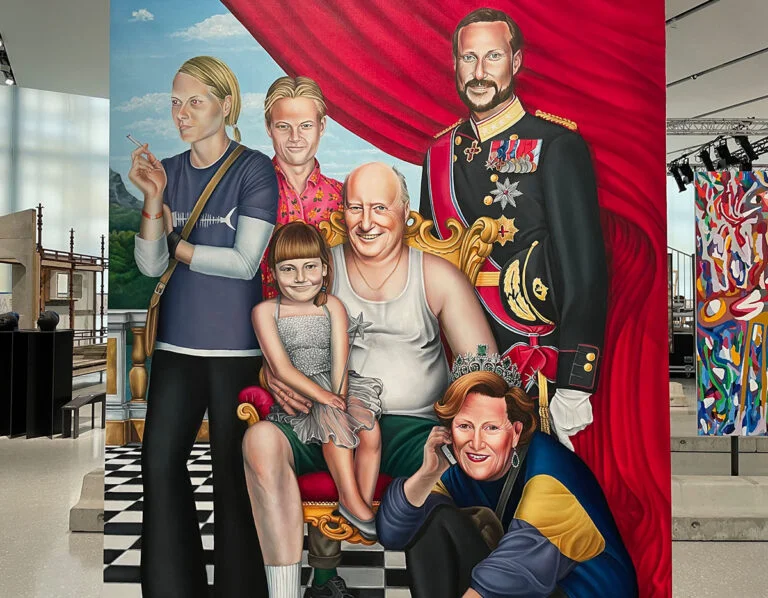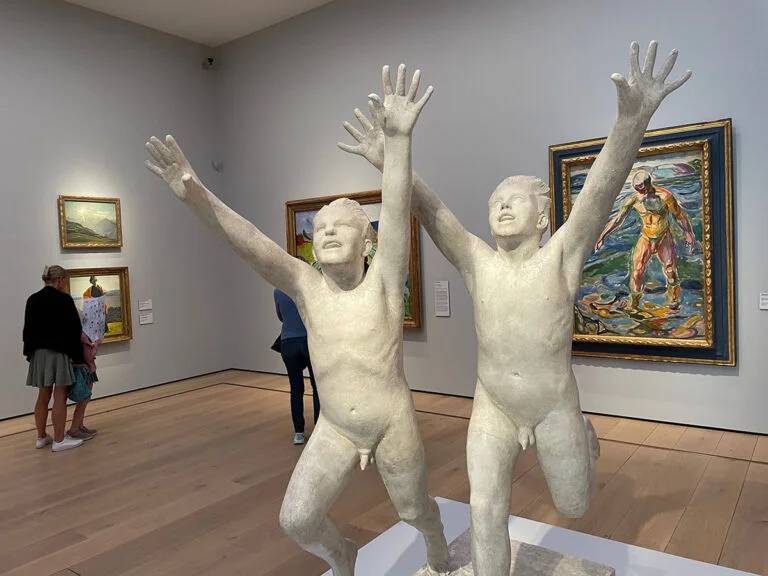The new National Museum in Oslo has opened its doors to the public. Here are 10 must-see exhibits to check out when you visit.
After many years of development including several lengthy delays, the new National Museum of Norway is finally open to the public. The ‘big, grey box' as it has been dubbed by critics holds few clues as to the contents.

I recently took a trip to the capital and spent several hours wandering the vast new museum. Whatever you think of the exterior, you can't fail to be impressed by what's inside.
Introducing the new National Museum
The new museum replaces four previous buildings including the former National Gallery. It's home to more paintings, contemporary art, and design and crafts from the full collection than ever before.
“Norwegian politicians decided to bring these four collections into one to have an institution that was able to tell the whole story from antiquity up until today about visual arts and culture”, said museum director Karin Hindsbo.
As with the new Munch Museum, the building's exterior has caused some controversy. Some call it grey and soulless, but I quite like the final result. It stretches out behind the Nobel Peace Centre so you don't actually appreciate the building's full size from any one angle.
With 13,000 square metres of exhibition space, Norway’s National Museum is bigger than Amsterdam’s Rijksmuseum and Bilbao’s Guggenheim. That presents a challenge for visitors in knowing what to see.
Having just visited for the first time, here are my top ten suggestions for must-sees when visiting the National Museum in Oslo, Norway.

You won't find many paintings on this list, even though the collection is colossal. That's no reflection on the quality of artworks on display throughout the enormous second floor.
Bear in mind that even though the National Museum is vast, the full collection is far bigger than what's on display at any one time. This means that some exhibits could be removed at a later date. Some of the highlights I've picked out below are also temporary exhibitions. I've tried to make a note where this is the case.
Reindeer skull curtain
There is a large amount of artwork born out of protest on display in the museum. One of the most impressive, thought-provoking and controversial is actually on display in the foyer.

Guests are greeted by a tapestry made up of 400 polished reindeer skulls–pierced by bullet holes–by Sámi artist Máret Ánne Sara. It has been used as a Sámi protest symbol against policies of the Norwegian state for many years.
The fact it is on display in Oslo is the result of lengthy debate and negotiation. If the museum decides to remove the piece from the foyer, it must be returned to a museum in the Sámi area of Northern Norway.
Edvard Munch room
Without doubt, the number one attraction for the new museum is the return of the Edvard Munch room. While the waterfront Munch Museum takes a deep dive into the artist and his work, the Munch room presents the highlights.

As Norway's most famous artist, Munch's room is understandably popular. But as with the old national gallery, it's much easier to see his famous works such as The Scream in relative peace compared with other art museums in Europe.
Lena Trydal's Royal paintings
Up at the top of the museum is the vast Light Room, by far the biggest temporary exhibition space in Norway. Several pieces in the inaugural exhibition ‘I Call It Art' caught my eye in here, but none more so than the colourful work of Norwegian artist Lena Trydal.
It's rare to see Royal portraits looking anything other than super formal, so these tongue-in-cheek portraits were a welcome sight.

Two oil on canvas paintings were on display. The one above depicting the Royal Family was created in 2021 as a second edition, while another featuring Princess Märtha Louise is from 2019.
As I write this, the current exhibition in the Light Hall is only on display for another few weeks.
Norwegian fairytales
Tales about mysterious and supernatural beings exist in all cultures, passed on through generations. Norwegian folk tales often describe creatures such as trolls that inhabit the forests and mountains.

This wonderful fairytale room captures the spirit of the work with a tree at its centre. On display you'll find work by Erik Werenskiold and Theodor Kittelsen.
East of the Sun and West of the Moon
For fans of Theodor Kittelsen, the temporary exhibition ‘East of the Sun and West of the Moon' is a must-see. It's in place until the end of 2022.

The exhibition shows off 150-year-old drawings made to illustrate the Norwegian folk tales captured by Peter Christen Asbjørnsen.
Many drawings are framed, such as ‘Once upon a time' by Theodor Kittelsen, drawn for the story ‘The House Mouse and the Country Mouse'. Others are displayed in context with the stories.
Vigeland plaster cast
Many visitors to Oslo head to Vigeland Sculpture Park. The granite and bronze sculptures are some of the city's top tourist attractions. Some of the best loved are the statues of children located along the bridge.

One of the reasons Vigeland was so prolific is that he did the majority of his work in plaster casts, leaving the actual sculpting to a team of assistants.
The park's on-site Vigeland Museum is home to plaster casts of some of the famous sculptures. One of those casts is on display at the National Museum. The collection also includes many of Vigeland's original sketches.
Norwegian fashion designers
Norwegian fashion is profiled to a bigger audience than ever before in the new museum. I knew next to nothing about fashion in Norway, so it was an interesting learning experience for me.

Pieces from renowned Norwegian designers including Per Spook and Peter Dundas are on display, together with younger designers who are quickly establishing a reputation in the fashion world.
In another room, numerous items from the royal costume collections of Queen Maud and Queen Sonja are on display.
Blue dragons and white gold
This eye-catching porcelain vase decorated with a lively blue dragon is the centrepiece of a room tracing the story of ceramic art from prehistoric earthenware to fine porcelain, so-called white gold.

The large onion-shaped vase dates from the region of the Yongle Emperor (1403-24). In this early Ming period, porcelain production was perfected but small blemishes can still be seen.
The full collection from China, Japan and Korea includes ceramics but also bronze, lacquer work, costumes and textiles.
Greek and Roman sculptures
A highlight of the museum's early design rooms are the impressive Greek and Roman busts, sculptures and reliefs.

Part of the Face to Face exhibition that introduces the theme of the human condition through history and in the present, the exhibition includes large groups of 3D figures depicting important myths and legends.
One of several located throughout the museum, a drawing station in this room allows visitors to sketch their own version of the sculptures.
The Scandinavian design story
As the design section of the museum moves through chronology, we eventually get to the birth of the now world-famous Scandinavian design movement.

The exhibition covers furniture and interior design, industrial and graphic design, focused on Norway but from a global perspective. One curious addition to this exhibition is the Norwegian voting booth!
Have you been to Norway's new National Museum yet? If so, what were your favourite parts of the collection? Let me know in the comments.

